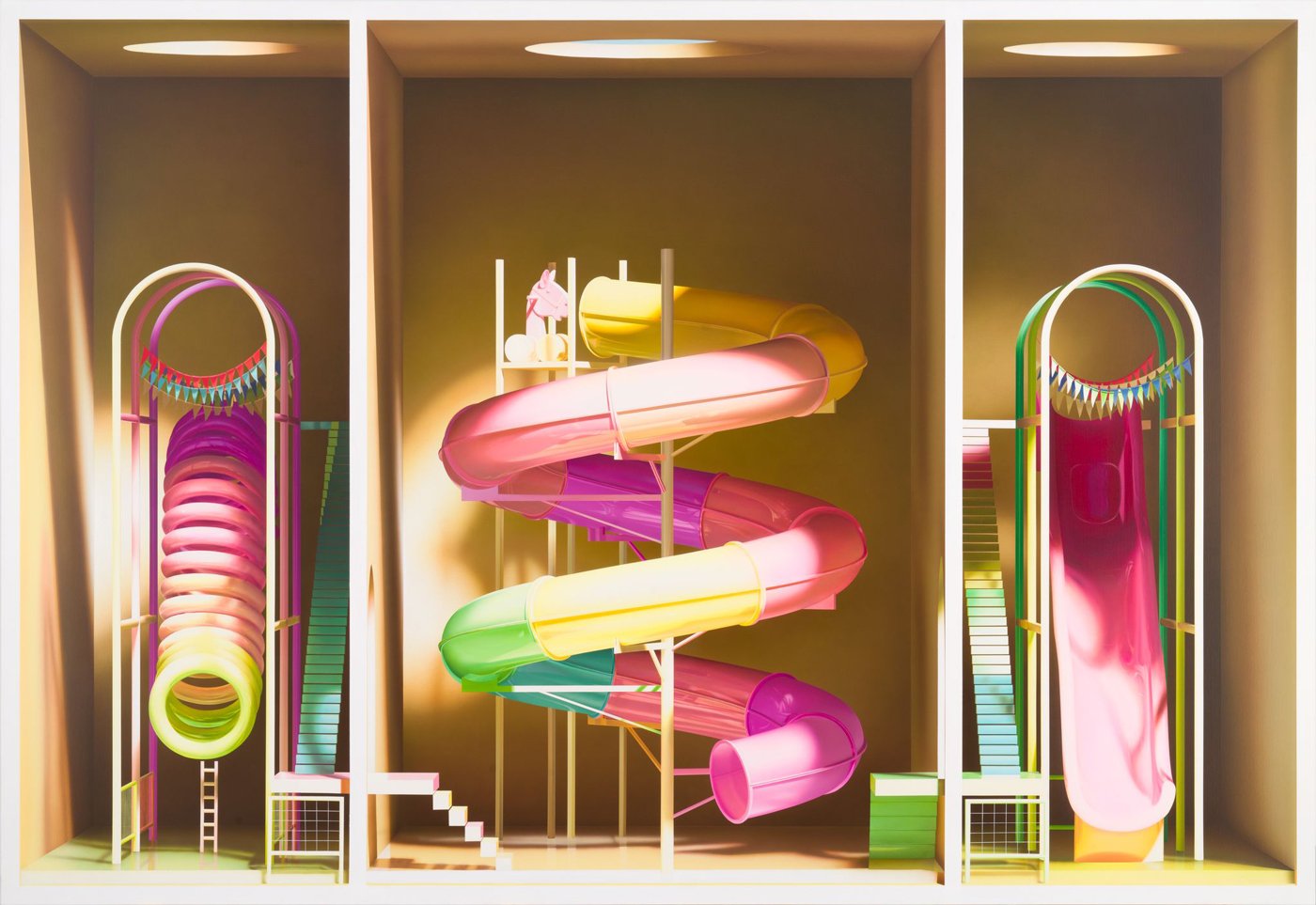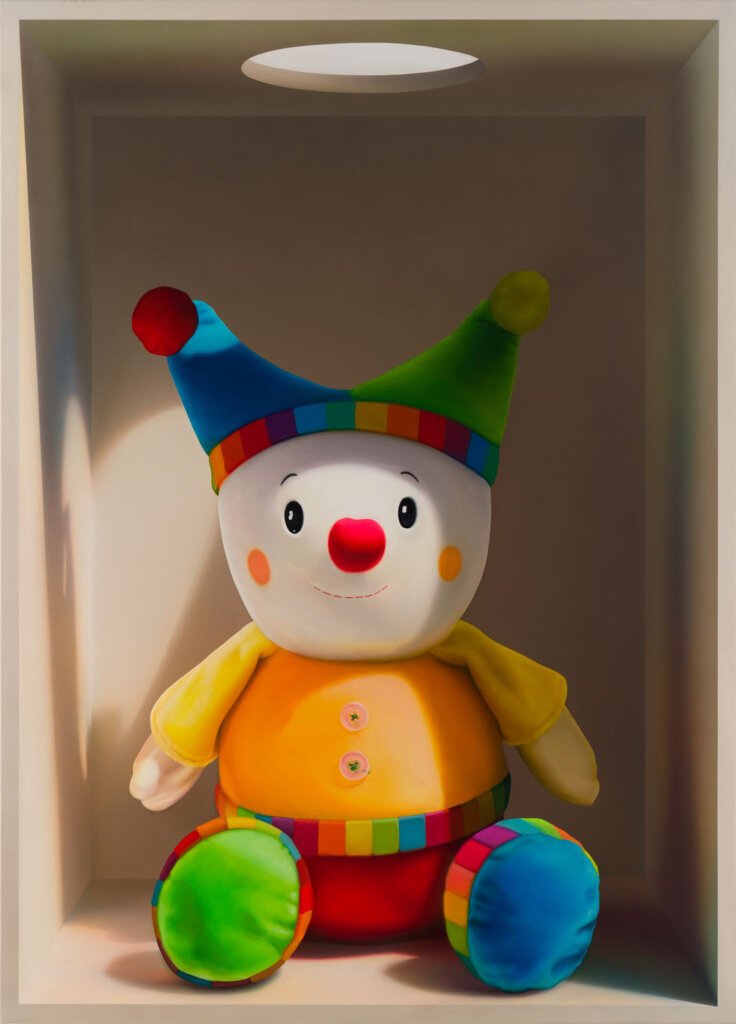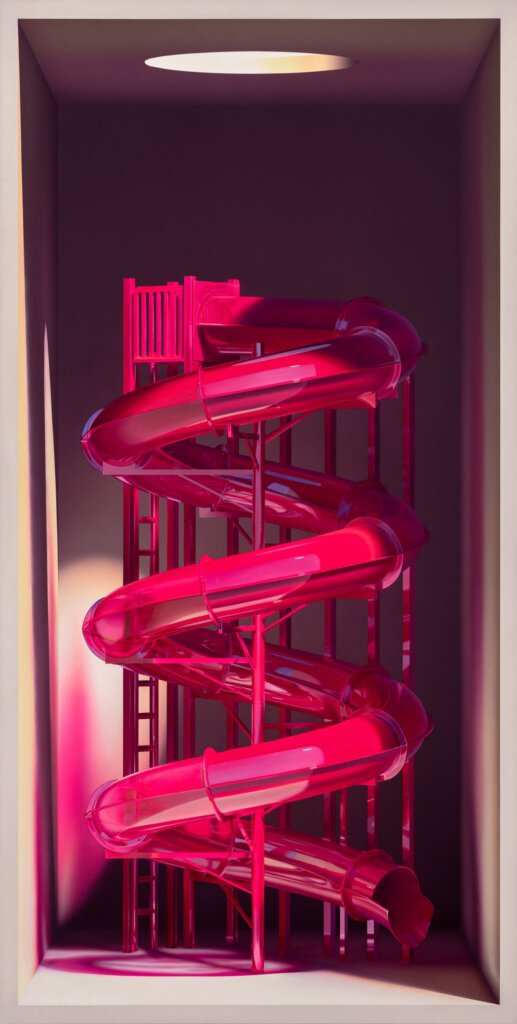Mehdi Ghadyanloo: The Untold Stories
March 1 – April 6, 2023
Almine Rech
Grosvenor Hill
Broadbent House
London, W1K 3JH
On the face of it, Mehdi Ghadyanloo’s current series of paintings is made up of a set of simple components: light and colour. The traditional components of painting. Plus boxes. Painted ones. Open to the front. Acting as a kind of frame. Traditional too you might say. And then, of course, there’s the deployment of all of these–light, colour, boxes – to create the illusion of an enclosed, three-dimensional space.
Often toplit via a circular opening in the box. A spotlight of sorts. And in the boxes, beneath the light are a series of brightly coloured children’s toys, and playground slides and rides (configured in ways that are invented by the artist), all depicted as if, well, thanks to the artist’s skill at creating trompe l’œil, fresh out of the box.
There’s a grinning, plush, child’s clown, its colourful outfit allaying any fears of any It-like manifestation. A song of innocence if you like. Other boxes contain a toy elephant on wheels painted in a slickly glossy red, or a white, wooden horse of similar design. Or a more modern playground horse made up of translucent plastic-looking silhouettes mounted on a coiled spring.
Another variant offers a kind of aluminium-looking unicycle from which rears a horse’s head. And the handles that make it ridable. For all that they are enclosed, at times even claustrophobic, the boxes also offer a space of fantasy. A space of play. A memorial to the joys of childhood. A form of nostalgia for those of us who are adults. Or hope for those of us who think the time for play is at an end.
Back in 1938, in a book titled Homo Ludens, the Dutch historian Johann Huizinga proposed that play was a cornerstone in the development of culture. In it, he proposed the following definition of his subject: ‘we might call it a free activity standing quite consciously outside the “ordinary” life as being “not serious”, but at the same time absorbing the player intensely and utterly. It is an activity connected with no material interest, no profit can be gained by it.
It proceeds within its own proper boundaries of time and space according to fixed rules and in an orderly manner. It promotes the formation of social groupings that tend to surround themselves with secrecy and to stress their difference from the common world by disguise and other means.’ Each of these elements is one that Ghadyanloo enunciates.
Our eyes follow the free movement of his slides, propose the activation of the toys, move freely through what is, in the end a two-dimensional space. We are absorbed. And a little manipulated. We follow the suggestion of rules for these games that the artist sets out. Albeit subtly. And it’s a mix of regulation and freedom that governs the artist’s moves too. “For me it’s more like architecture,” he says. “You put an element, make it bigger, smaller, change the light and change the colour and everything. It’s a process.
You love something like you like a toy, and to make it yours, you need to modify it in terms of shape, height, curves, colours, light, shadow, shine, contrast, and everything. It’s like many factors of design and challenge for me. When I have everything and start painting the idea, when I finish the painting, like a blueprint for an architectural building, when it’s finished, again it starts another process because you see it in reality. You start to modify, change it, and it’s a never-ending process.” Of play.
There is a play here too with art-historical precedents: with Giorgio Morandi’s still lives, the fantastic architectures and play of light and shade in the works of Giorgio de Chirico, a hint of the playfulness and self-contained worlds of Marcel Duchamp’s Boîte-en-Valise (1935-41), the fantastical slides and ladders of Dutch artist Constant Nieuwenhuys’s city of play, New Babylon (1956–74), an imagined postwar utopia in which people were liberated by freedom rather than oppressed by work. These themes come together in the Escheresque painting The Untold Artwork (2022), a labyrinth of large slides and diminutive stairs and ladders, full of luminous pinks and greens and rainbow patterns.

It’s reminiscent too of Andy Warhol’s lurid palette and fascination with the everyday (one might imagine this work with the colourful slides and lurking toy horses to be a eulogy to plastic; and plasticity). Yet there’s also a slightly sinister undertone lurking in the shadows – why the gulf in scale between snakes and ladders? Where does this fantastical architecture of play actually lead us? What does this work say about the constraints of the real and the escapism of the imaginary? How does one escape the box?
Yet despite these prompts towards art-historical speculation (there’s no reason to think that the artist is aware of all these precedents), that’s not to say that there isn’t a lot of Ghadyanloo’s own experience in there too. His works display some of the influence of Sufi philosophy between the interiorisation of his boxes and the dances and pirouettes of his slides.
His own childhood in Iran took place under the shadow of the Iran–Iraq War (1980–88) when, as the artist puts it, joy meant, above all, one’s relatives returning safely home. His children’s childhood is taking place in a world in which ‘play’ is increasingly the preserve of the digital and virtual spheres. As much as Ghadyanloo’s boxes are spaces of play, they are also spaces that express his control – of the direction and intensity of light, of the movements suggested by the toys and architectures and of the stage-like space of his boxes.
An antidote in some ways to a world that seems increasingly out of control, with earthquakes in Turkey, war in Ukraine and the aftermath of a global pandemic. Boxed yet free, descriptions of journeys and hints of possible outcomes, his works describe a space that is at once limited and full of potential. Scenes of hope rising out of despair.
©2023 Mehdi Ghadyanloo







